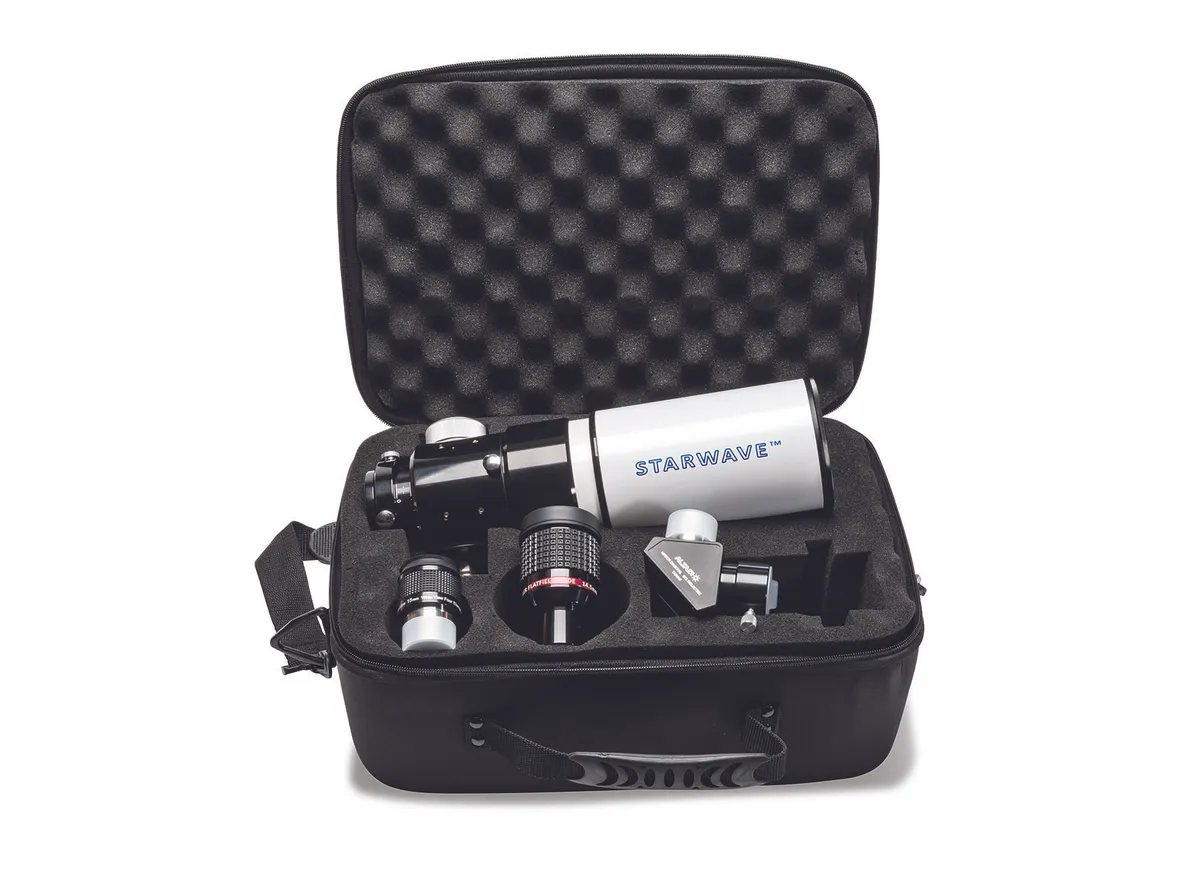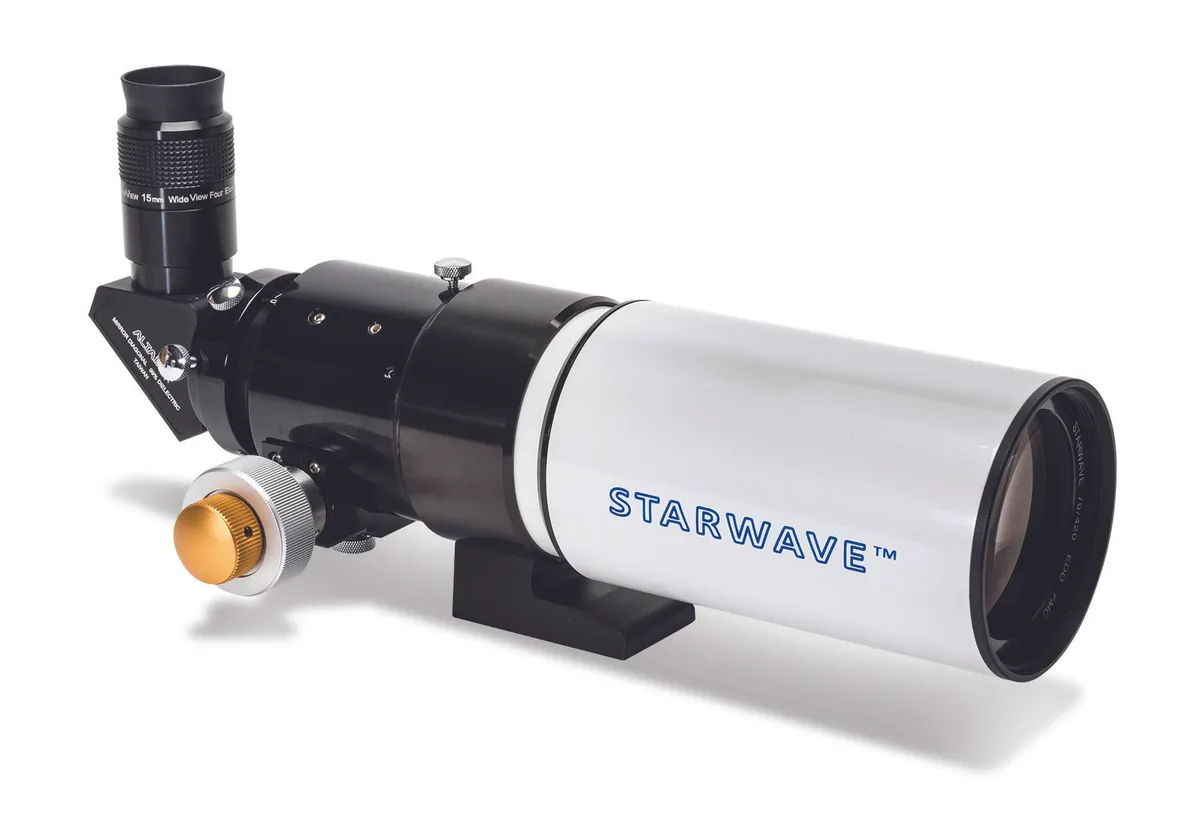The Altair Astro Starwave ASCENT 70 ED refractor is a cost-effective travel option for amateur astronomers. We were interested to see what it could do both as a visual system and as an imaging scope.The Starwave 70 ED is a 2.75-inch, 420mm focal length telescope just 300mm long; 380mm with the dew shield extended.
The objective lens is a doublet – meaning it has two elements – made from extra-low dispersion (ED) glass.
The doublet design helps to correctfor any colour fringing around bright stars, which is an optical error where not allcolours are brought to the same focus.
The 2-inch focuser is a Crayford design witha dual-speed 1:10 microfocuser and comes with a 2- to 1.25-inch adaptor.
The back of the focuser unscrews to reveal a M54x0.75 female thread – with the right adaptor, you could attach a camera and use this scope as a telephoto lens for astrophotography.
The scope is supplied in a soft, well-padded case with several compartments for accessories.For review purposes we were also loaned a star diagonal and 15mm 70ºeyepiece.
Overall build and construction was good and we were impressed with the compactness of the telescope tube.
The dew shield performed its job, though we would have liked to have seen a locking screw to keep it in place.That being said, the dew shield did not slip while we were using it.
The back section can be rotated through 360º, which is useful for imaging as it gives you more flexibility when framing targets. This part of the scope does havea locking screw, but there was a little play when rotating it with a DSLR attached.
For our visual tests we used the loaned dielectric star diagonal and 15mm eyepiece, plus a trusted 26mm eyepiece of our own.For closer views ofthe Moon, planets and double stars, we alsoadded a 2x Barlow lens and a 5x Powermate toboost the magnification.
The multicoated optics performed well as we scanned the stars: with the 26mm eyepiece we found the view of Altair (Alpha Aquilae) crisp across the central 80% of the view, with slight distortion towards the field edge.
There was a little colour fringing on the brightest stars, but overall it was well controlled.

The 26mm eyepiece gave a magnification of 16x, and with it we could easily fit the three stars of Orion’s Belt into the view.
The 15mm eyepiece gave a lovely view of the Andromeda Galaxy as it stretched across the view and the Pleiades star cluster sparkled, with a hintof the Merope nebulosity visible with avertedvision.
We also enjoyed a good view of the galaxy pair M81 and M82.
By this time Jupiter was rising, so we turned to it and coupled the 26mm eyepiece with the 5x Powermate to reveal two of the planet’s belts and all four Galilean moons.
Later in thenight we aimed at the Moon and also found itto be reasonably detailed, even though this isa wide-field telescope.
We then attached our Canon EOS 50D DSLRand managed to capture a decent view of the Pleiades, despite the vagaries of the weather.
We took 36 exposures, each two minutes long.Although we did notice some colour fringing on some stars in this, we were able to both control it and bring out a wealth of nebulosity during processing.
A field-flattener could deal with the slight star distortionwe noted towards the edges of the field of view.
We wish we had more clear nights to use the Starwave 70 ED.For the price it is a good all-round small scope ideal for a beginner when you add a star diagonal and an eyepiece, or for wide-field imaging.
Lightweight and travel friendly
What impressed us most about the Starwave 70 ED was how light it is – just 2kg.With its compact size of just 300mm with the dew shieldretracted, it is ideal as a travel scope.
It’s easy to transport safely too, thanks to the padded soft case that comes with it.The case has compartments for accessories and will fit within the confines of most airline luggage restrictions.
The telescope’s mounting footallows for it to attach to a typical photographic tripod – perhaps your best bet if you wantto take it abroad – or to a Vixen-style mountfor astrophotography at home.
By adding a star diagonal, eyepiece anda photographic tripod the Starwave becomesa highly portable visual instrument withoutadding too much to its weight.
If you area solar eclipse chaser, consider pairing this scope with a appropriate solar filter – it is also ideal for taking away on eclipse expeditions without costing the Earthin excess baggage charges.

Body
The tube is attractively finished in white and black.The internal matt coating and baffles do a good job in cutting down on any internal reflections that can spoil the contrast in faint deep-sky objects.
Dew shield
The retractable dew shield was slightly loose for our liking, but it was still easy to retract for storage after use.It gave reasonable protection from dewing up under normal conditions and did a good job of cutting out extraneous light as well.However, we would like to have seen a locking screw included.
Focuser
The focuser is a dual-speed Crayford design with a microfocuser for fine control.It was easy to operate and can be locked in place with a locking screw, although we did note a little image shift.It is designed for 2-inch eyepieces and is supplied with a 1.25-inch adaptor.
Optics
The objective lens is made from ED glass and all surfaces are multicoated.The doublet design visuallygave good views of the night sky; photographicallythere was slight colour fringing noticeable on somestars, but this was a minor issue.
Rotatable rear section
The back section can be rotated through 360º and has a locking screw to hold it in place.This is especially useful for imaging purposes as it allows you to better frame targets on your camera’s sensor.There was a little image shift but this is easily compensated for.
Vital stats
- Price£299.00
- Aperture70mm (2.75 inches)
- Focal Length420mm, f6
- Weight2kg
- SupplierAltair Astro
- Telephone01263 731505
- www.altairastro.com
This review originally appeared in the January 2014 issue of Sky at Night Magazine.
